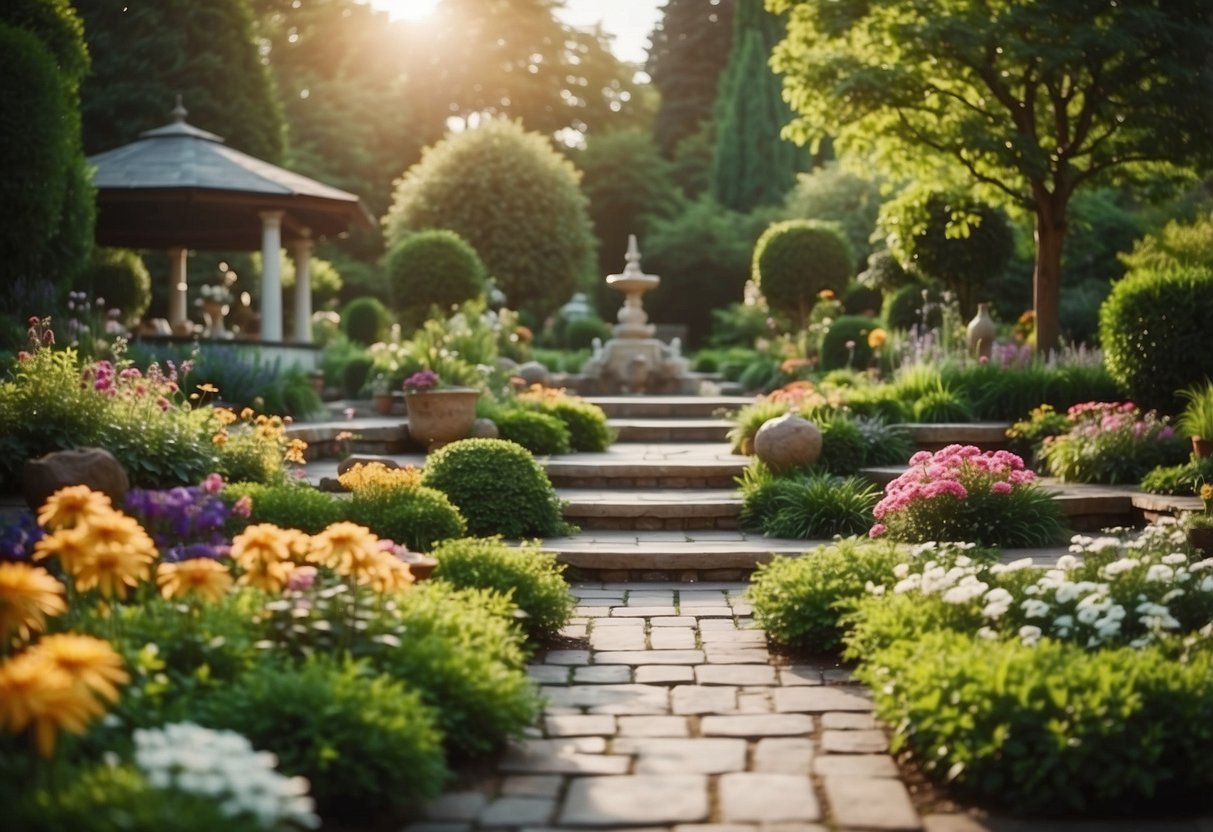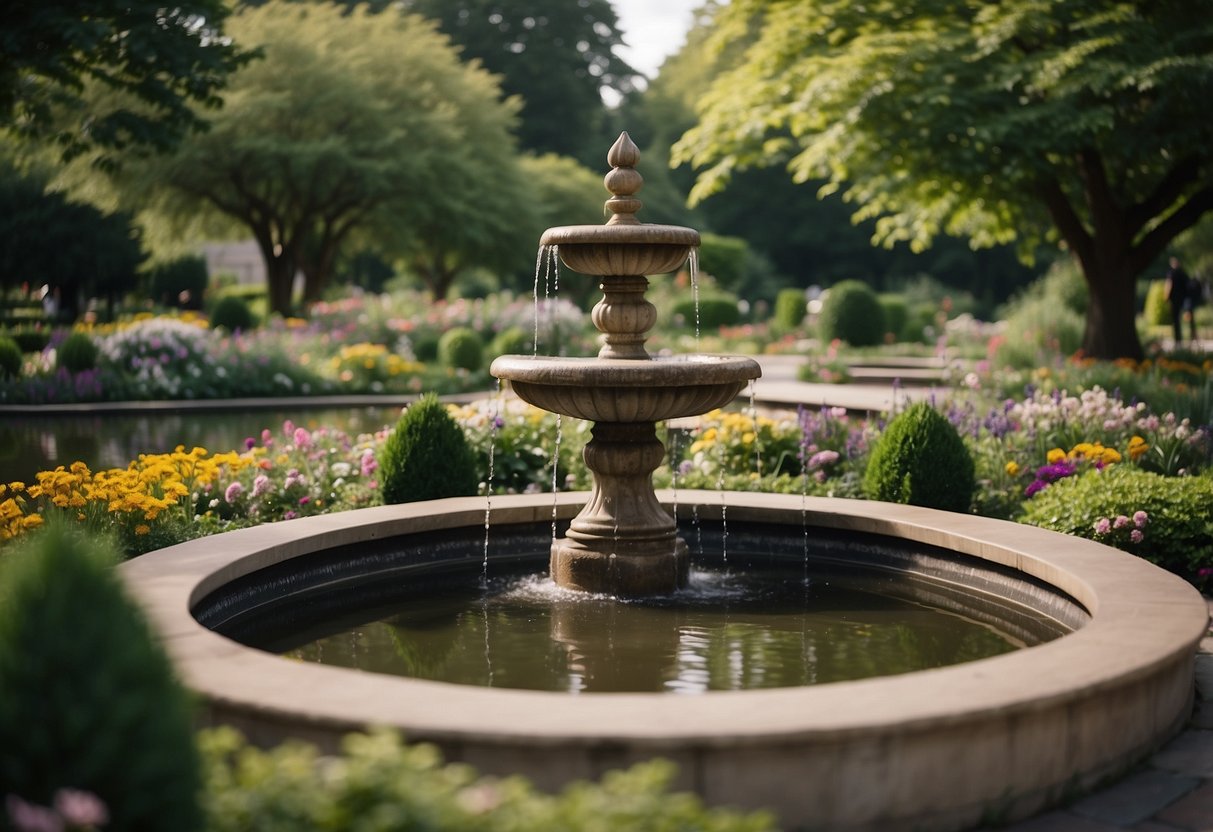Public Garden Design Ideas: Transforming Community Spaces
Public garden design offers a wonderful way to enhance community spaces and bring people together in green, serene environments. Creating beautiful and functional gardens can transform urban areas into vibrant outdoor retreats. Whether you are a professional landscaper or a gardening enthusiast, you will find inspiration and practical ideas to design stunning public gardens.

Exploring various landscape styles and plant selections can help make your public garden a local treasure. From incorporating seasonal blooms to using sustainable materials, there are countless ways to achieve a unique and inviting space. With the right design, public gardens can become an essential part of your community’s daily life.
1) Butterfly Garden

Creating a butterfly garden can bring vibrant colors and life to your space. Choose plants that attract butterflies, such as milkweed, coneflowers, and lavender. Position the garden in a sunny area because butterflies prefer sun to shade.
Include rocks or pavement to help them warm up in the morning. Group plants in clusters to make it easier for butterflies to find them. To create a striking display, consider adding aster, purple coneflower, and black-eyed susan. Make sure to provide shelter from strong winds and predators like birds. Go organic to avoid harming the butterflies. For more detailed ideas, check out this garden guide.
2) Herb Spiral

Herb spirals are a fantastic way to grow herbs in a compact space. The spiral design lets you plant different herbs in various microclimates, from dry and sunny at the top to moist and shady at the bottom.
You can build an herb spiral with materials like bricks, stones, or wood. It’s a fun and creative project that’s also very functional.
For more detailed instructions, visit Creative Vegetable Gardener and Balcony Garden Web.
3) Zen Rock Garden

A Zen rock garden, also known as a karesansui, is a minimalist garden that can bring peace and tranquility to your space. This garden features natural elements like rock, gravel, sand, and wood.
To start, arrange rocks in a way that promotes balance and simplicity. Next, add a layer of fine gravel or sand.
You can also use a rake to create patterns in the gravel, symbolizing the flow of water. Incorporating water features or simple plants can enhance the serene atmosphere.
Keep it simple and let the garden be a place for quiet contemplation.
4) Wildflower Meadow

Creating a wildflower meadow in your garden can bring vibrant colors and attract helpful insects. It’s a fantastic way to add a touch of natural beauty.
Choose a sunny spot with well-draining soil. Plant a mix of native wildflowers like purple coneflower, black-eyed Susan, and butterfly weed. These flowers are great for pollinators.
Consider adding some ornamental grasses to give the meadow a more structured look. Care for your wildflower meadow by weeding and watering as needed.
Enjoy the lively, ever-changing landscape that a wildflower meadow offers.
5) Water Feature Garden

Adding a water feature to your public garden can create a peaceful and attractive spot. Consider a small pond where you can plant water-loving plants like lilies.
A simple fountain can also be a beautiful addition. The sound of trickling water will help visitors relax.
For a more modern touch, you might try a sleek, narrow pool. Line it with evergreens or hostas for a stylish look. For more ideas, check out these water feature inspirations.
6) Vertical Garden

A vertical garden is perfect for small spaces. You can create a stunning display using simple materials like wooden pallets, trellises, or wire mesh panels.
Planting vertically not only saves space but also adds a unique visual appeal to your garden. It’s ideal for growing herbs, flowers, and even vegetables.
Consider using pocket pouches or hanging containers to maximize your wall space. This method works for both indoor and outdoor areas, bringing nature closer to eye level. For more creative ideas, check out these vertical garden designs.
7) Sensory Garden

A sensory garden is designed to engage all five senses: sight, smell, sound, touch, and taste. You can plant herbs like lavender, thyme, and oregano for their pleasant aromas.
Include bright, colorful flowers to catch the eye. Use textured plants that invite touch, like lamb’s ear.
Install a small water feature to create soothing sounds. Edible plants such as strawberries and tomatoes can add to the experience as well. Create a comfortable seating area so you can take in all these sensations at once.
8) Cottage Garden

A cottage garden is a charming choice for public spaces. It features a mix of flowers and greenery, giving it a lush, informal look. This type of garden typically includes plants of different heights and colors. Ladybird red poppies and astrantia flowers add vibrant hues and attract beneficial insects, like bees and butterflies.
Consider underplanting trees with seasonal blooms. This adds visual interest and can make otherwise dull areas more attractive. Plus, using decorative items, like antique watering cans or sundials, can provide focal points without cluttering the space. Make sure your paths and borders are natural and meandering rather than rigid and straight.
For more ideas, visit Country Living and Homes & Gardens.
9) Topiary Garden

A topiary garden uses clipped evergreens to create beautiful shapes. These shapes can include cubes, cones, and even animals. You can add topiary in different shapes to your garden design to make it more interesting.
Topiary gardens are a great way to show creativity. With the right tools and some planning, you can create stunning designs. You might find inspiration from public topiary gardens featuring various shapes. Adding topiaries in your garden can make it stylish and eye-catching.
10) Rooftop Garden

A rooftop garden can be a delightful escape in the middle of the city. You can use vertical space to add more appeal by hanging planters on the walls and using railing planters. Adding climbers like ivy can transform bare walls into lush green areas (link).
Don’t forget the flooring. Choose a type that fits your budget and suits your local climate (link). Privacy can be enhanced with dense greenery, creating a cozy and secluded space (link). Small touches like compact outdoor kitchens can make your rooftop a multifunctional oasis.
Fundamental Principles of Public Garden Design

A successful public garden design includes careful planning, attention to the environment, and the use of suitable plants. These elements ensure that the garden is both beautiful and sustainable.
Understanding the Space
Before designing a public garden, it’s crucial to know the space you have. This includes the garden’s size, shape, and natural features. Start by mapping out the area and noting where the sun hits and where shadows fall.
Consider how people will move through the garden. Wide paths make it easy for visitors to stroll. Think about placing benches in shady spots for rest. Look for existing trees, water bodies, and other features that can be integrated into the design.
A master plan helps visualize the entire layout. Be flexible and ready to adjust as you go. Consistent design elements like repeating paths or plant types can give the garden a unified look.
Incorporating Native Plants
Using native plants in your garden is essential for both aesthetic and ecological reasons. Native plants are adapted to the local climate and soil, which means they require less water and care. They also support local wildlife, such as birds and insects.
Start by researching which plants are native to your area. Choose a mix of trees, shrubs, and flowers that bloom at different times of the year to ensure color throughout the seasons. Native plants can create a natural, effortless look.
Grouping plants with similar needs together makes maintenance easier. Use local resources or consult with a nearby botanical garden for advice on the best plants to use. This way, your garden thrives with minimal effort and supports the local ecosystem.
Design Elements and Styles

When planning a public garden, think about the look and feel you want to create. Two primary styles that can shape your garden are Modern Garden Trends and Classical Garden Inspiration.
Modern Garden Trends
Modern gardens focus on clean lines, minimalism, and functional spaces. You might use materials like concrete, metal, and glass. Plants are often selected for their architectural shapes and colors.
Features to consider:
- Geometric Layouts: Use straight lines and shapes.
- Sustainable Elements: Incorporate drought-tolerant plants and recycled materials.
- Outdoor Living Areas: Create spaces with furniture for relaxation and socializing.
Lighting can also play a significant role. LED lights can highlight specific plants or pathways, making the garden both functional and beautiful after dark.
Classical Garden Inspiration
Classical gardens draw inspiration from historic European designs, emphasizing symmetry, order, and lush plantings. Think about including pathways lined with topiary, fountains, and ornate statues.
Key Elements:
- Symmetry: Balance elements on either side of a central axis.
- Traditional Materials: Use stone, brick, and wood for a timeless look.
- Rich Plantings: Include perennials, roses, and hedges.
Decorative elements, like urns and benches, can add to the charm. Water features, such as ponds or fountains, not only provide visual interest but also create a soothing atmosphere.
Both styles have their unique appeal and can greatly enhance the beauty and functionality of a public garden. Choose the one that best fits your vision and the needs of your community.
Sustainable Public Garden Practices

Sustainable public garden practices focus on conserving water and maintaining healthy soil. These methods help create gardens that are eco-friendly and beneficial for the community.
Water Conservation Techniques
One of the most important practices is water conservation. Using techniques like rainwater harvesting allows you to collect and store rainwater for later use. Installing a rain barrel or water butt under a downpipe helps capture rainfall, reducing the need for tap water.
Drip irrigation is another effective method. This system delivers water directly to the base of your plants, minimizing waste from evaporation and runoff. It also keeps foliage dry, helping to prevent diseases.
Mulching can further aid in water conservation. Applying a layer of organic mulch, such as wood chips or straw, helps retain soil moisture, cools the ground, and reduces water evaporation. This makes less frequent watering necessary.
Soil Health and Composting
Maintaining soil health is crucial for a sustainable garden. One way to do this is through composting. Composting organic waste like kitchen scraps or garden clippings turns them into nutrient-rich compost. This not only reduces landfill waste but also improves soil structure, provides nutrients, and encourages beneficial organisms.
You should also consider crop rotation to maintain soil fertility. By planting different types of crops in the same area in successive seasons, you can prevent soil depletion and reduce the buildup of pests and diseases.
Cover cropping is another useful technique. Growing cover crops, such as clover or legumes, during off-seasons can add organic matter to the soil, suppress weeds, and prevent erosion. This ensures that your garden remains productive and sustainable year-round.
By integrating these water conservation and soil health practices, you can create a sustainable and thriving public garden.







